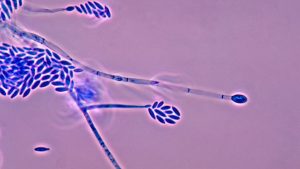#106: Calostoma cinnabarinum, the Stalked Puffball-In-Aspic
This is without a doubt the strangest-looking puffball-like mushroom in North America. It starts out looking like the inside of an oddly-colored egg and ends up resembling a little, red balloon glued to the top of a tiny termite mound. This description really doesn’t do the mushroom justice, so please do an image search for “Calostoma cinnabarinum” to see what the mushroom actually looks like.
C. cinnabarinum has the common name “Stalked Puffball-In-Aspic” because when young, the mushroom is covered by a thick glob of gelatinous material. At the center of the clear, gelatinous layer you can see a red circle that will get bigger and become the spore-producing part of the fruiting body. Early on in the formation of the mushroom, however, it looks like someone cracked open an egg and left the insides on the ground… except that the “yolk” is red. Other apt descriptions that come to mind are The Blob and some kind of Halloween decoration that’s supposed to look like an eyeball.
As it matures, the mushroom sheds its gelatinous layer. This layer breaks into small pieces which end up littering the ground around the mushroom. Most of the pieces have a bright red piece in the middle of a small, gelatinous glob, somewhat like a pomegranate seed.
The main body of the mushroom stands in the middle of the debris atop a 2-4cm (0.8-1.6in) tall stalk. The stalk is 1-2cm (0.5-1in) thick, reddish, and highly reticulated. Because of the coarse, net-like reticulation, soil often gets stuck to the stalk, making it appear as though the stalk is simply an extension of the ground.
The stalk supports a bright red sphere (actually the spore case) that is roughly 2cm (nearly 1in) in diameter. Thanks to the deciduous, gelatinous layer, the spore case is usually free of soil and other debris. The spore case is completely smooth except for the very top, which has a pore that is slightly raised above the surface. Small ridges extend out from the pore center, making it look like a very tiny mountain. When raindrops strike the surface of the sphere, spores are puffed out of the pore. The spore case becomes paler as it ages, eventually acquiring the color of an egg that has been soaked in vinegar. Usually, the pore and its ridges retain the red color longer than the rest of the spore case. Inside the spore case, spores are produced in a white mass that turns buff to yellowish when mature.
There are a couple similar Calostoma species that can be found in North America. C. lutescens can be differentiated by its yellow spore case and longer stem (4-5cm, 1.5-2in). C. ravenelii also has a yellow spore case but does not produce a gelatinous layer. None of these species are edible, but they are super fun to find!
In North America, this mushroom can be found in the eastern and possibly southwestern areas of the continent. It fruits from spring through fall in areas with a lot of available moisture, such as moss beds or near creeks. C. cinnabarinum seems to prefer higher elevations, so look for it in places like the Appalachian Mountains.
Because of its unusual morphology, mycologists have had a hard time deciding where to place the genus Calostoma. Before molecular techniques became widely available, the genus was moved around between the stinkhorns, earthstars, and stalked puffballs. All of these families are saprobic, so Calostoma was assumed to be a saprobic genus. However, DNA analysis demonstrated that the genus should be placed with the boletes (which also contains the earthballs)! The boletes, of course, are a mycorrhizal clade. Further isotopic analysis confirmed that C. cinnabarinum is mycorrhizal with oak trees. Due to its taxonomic placement, C. cinnabarinum is not a true puffball. Instead, it should be included with the earthballs, even though it forms a single, regular pore and the spore case does not disintegrate at maturity.
See Further:
http://www.mushroomexpert.com/calostoma_cinnabarinum.html
http://students.clarku.edu/~awilson/research/Calostoma/ecology_C_cinnabarinum.html
http://www.rogersmushrooms.com/gallery/DisplayBlock~bid~5699.asp







![#011: Characteristics of Kingdom Fungi [Archived]](https://www.fungusfactfriday.com/wp-content/themes/hueman/assets/front/img/thumb-small-empty.png)


2 Responses
[…] they are actually highly-modified agarics! The other is the stalked puffball genus Calostoma (see FFF#106 for an example). These odd-looking stalked puffballs have a gelatinous outer covering that falls […]
[…] earthball morphology. The first of these is the stalked puffball genus Calostoma, which includes C. cinnabarinum. These odd-looking stalked puffballs have a gelatinous outer covering that falls off to allow […]